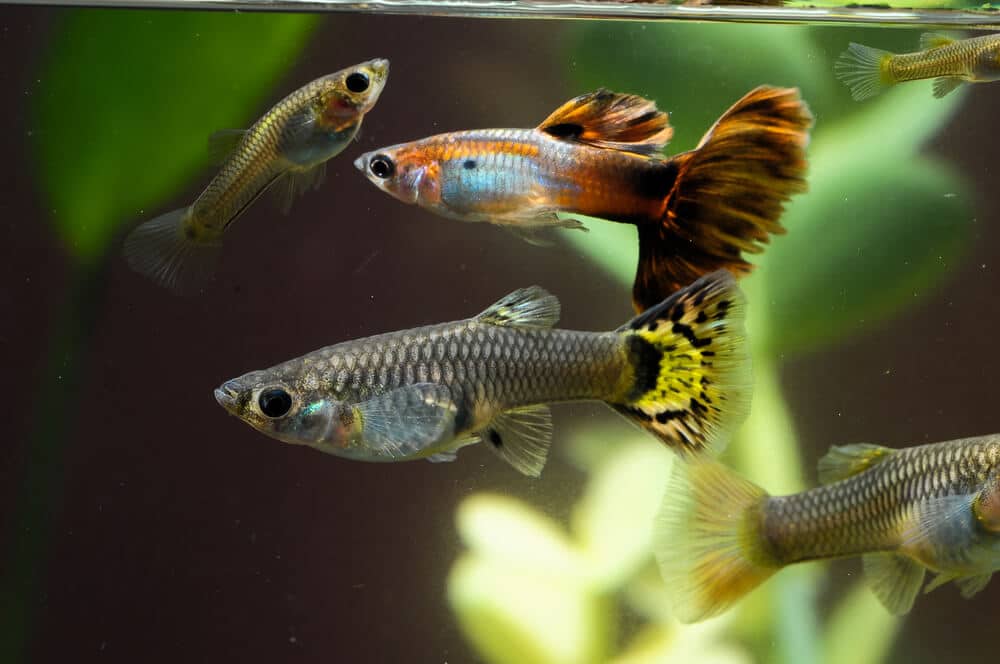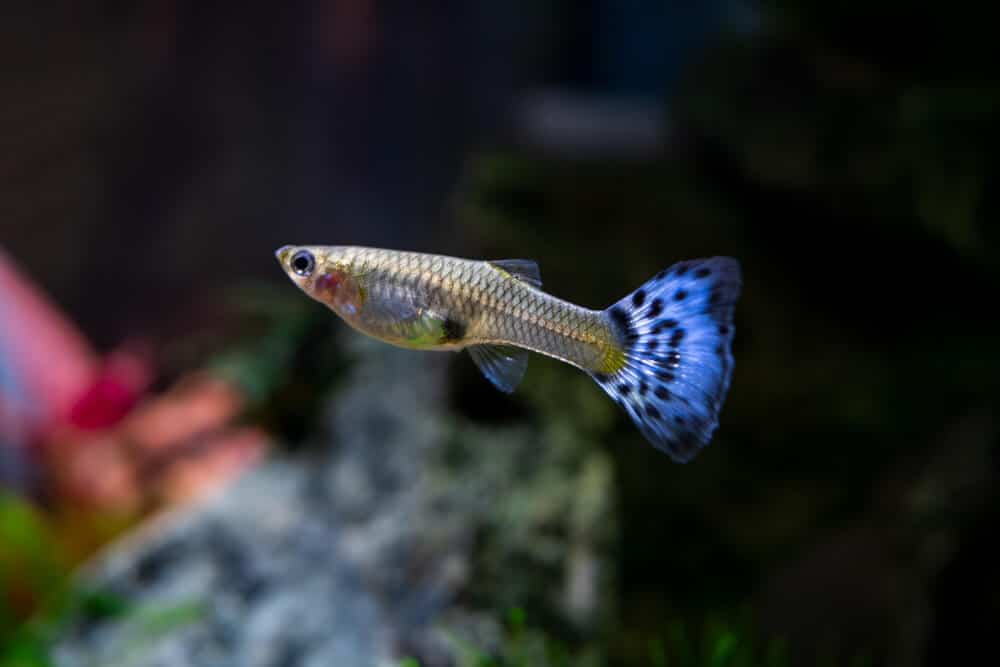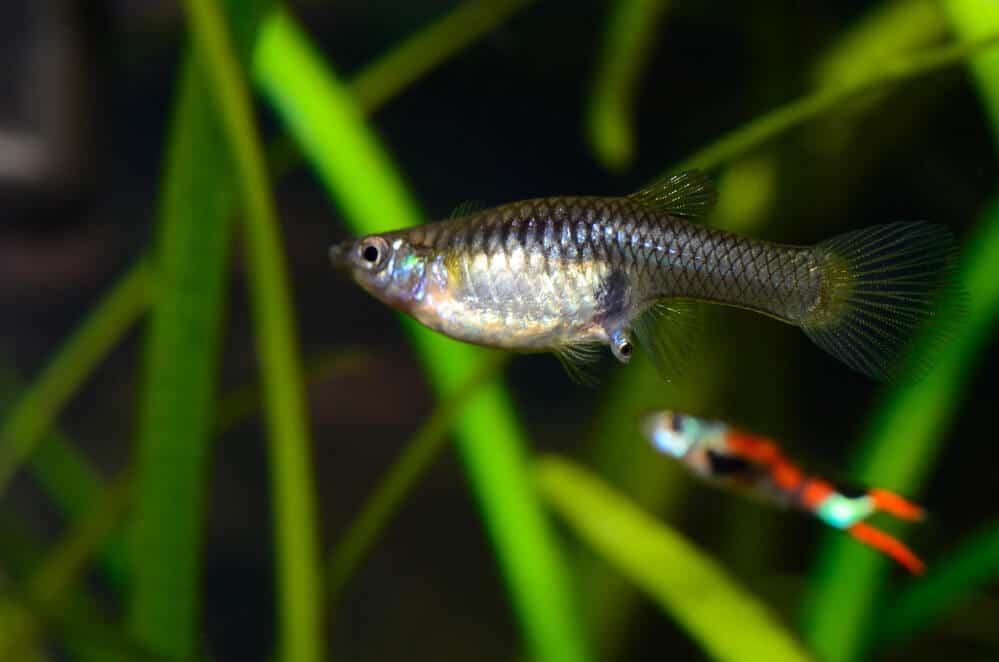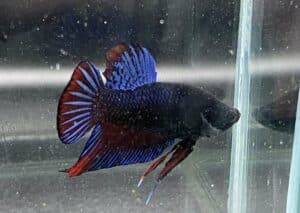Guppies have an excessively high birth rate which can cause overcrowding in an average tank quickly. So, it is essential for guppy keepers to learn how many babies their guppies have before going out and getting them for their aquarium.
Read on till the end as I share a detailed guide on the birth rate of guppies and other related information.
How Many Babies Do Guppies Have?
The breeding rate of guppies is very high. They can reproduce every month and give birth to 20 – 200 offspring every month. They live up to 4 years. And in this lifespan produce an average of 2000 guppies.
Guppies are tropical freshwater fish that originated in South America and are members of the Poeciliidae family. They are popular as community fish.
Their vibrant colors are also behind their immense popularity.
Guppy fish come in a wide range of colors, tail forms, and sizes, with over 300 distinct species. That’s what makes them great for aquariums.
Guppies provide a lot of color to an aquarium, are calm, energetic swimmers, and are extremely easy to care for. (Learn more about guppy fish care in this guide)
However, these fish have a very high breeding rate.

They are very proactive, not afraid to reproduce, and do not require the owner’s additional involvement. That is why another popular name for these beautiful fish is “million fish” for their excessive birth rates.
One of the main reasons why guppies reproduce so frequently is their quick maturation rate. Also, the gestation time for these fishes is around 1 month.
So they multiply very fast and overpopulate the aquarium. They are ready to reproduce at the age of 4 to 6 months. In addition to this, they give birth to a lot of babies every time they breed.
All of these factors raise the number of babies a guppy can have in their lifetime.
Guppies are livebearers, which means female guppies get pregnant and give birth to many baby fry at once. That is why an average guppy can breed around 2000 fry in its lifetime.
So, if you don’t want to overpopulate your aquarium, it is necessary that you keep female and male guppies apart.

1. How Long Does It Take For Guppies To Give Birth?
Guppies can breed all year round. After they become sexually active, they conceive very quickly. The pregnancy period differs from guppies to guppies. Usually, this period lasts for 21 to 30 days.
Guppies are very active in terms of reproduction.
Female guppies become mature and ready to give birth just when they are 4 to 6 weeks old. Once they become pregnant, this period is also not very long.
The usual range for the gestation period is around 3–4 weeks. However, the time can vary depending on various internal and external factors.
There are several factors that can contribute to the length of the pregnancy period of a guppy.
Whether the total time will increase or decrease is determined by the general health of the female guppy, water factors, nutrition, and tank water cleanliness.
For example, a warm tank is preferable for gestation and will prevent the female from becoming pregnant for a long period of time.
On the other hand, a female guppy may stay pregnant for longer if she is agitated or believes she is in danger.
Yet, sometimes extreme stress can shorten the gestation period and result in a miscarriage or sudden abortion.
If all the factors are at their optimum level, the average gestation period lasts from 22 days to 26 days.
2. How To Identify A Pregnant Guppy?

If you have guppies in your aquarium, you need to identify which guppies are pregnant so that you can take care of them. There are some clear indications you can look for. These indications include-
#1. Body Shape
Body shapes are one of the clear signs to identify if your guppy is pregnant.
A pregnant guppy’s abdomen will noticeably grow. You will also notice a significant difference between the sleek, skinny non-pregnant guppies and the pregnant ones.
At the base of the belly bump, your mother guppy may have a red or black triangular mark.
As the fry or babies grow, you may notice little black specks through the skin of the mother, which is basically the eyes of the baby fish. You won’t find these traits in a normal female guppy.
#2. Secretiveness
This is another trait that is very common in pregnant guppies.

A pregnant guppy will become reclusive as her pregnancy continues, hiding under foliage or the other structures you have put in your tank as decoration.
The mother is seeking a secure area to give birth to her offspring where they can hide from predators, which normally are the adult fishes in your tank.
So, if you want to breed guppies in your aquarium, you need to make proper preparations for it.
If your aquarium lacks full, lush plastic or live plants, you should add some so that the guppy fries have a secure place to hide when they’re born.
#3. Inactivity
As the days for breeding draw nearer, the more inactive the female guppy will be.
She will be more sluggish and slow in her usual activities. She will not swim all the time, but rather stay still in a corner. All of these are normal indications of a mother preparing to give birth.
So you need to be careful in times like this about the wellbeing of the female guppy.
Another important thing is that in addition to swimming slower, they will also eat less than normal.
However, it’s crucial to provide enough food so she can eat even if she’s no longer the quickest swimmer in the tank. Else, the babies won’t be healthy. It will also decrease the survival rate of newborn guppies.
Read Also: How Long Guppies Can Go Without Food?
#4. Body Contractions
As the time for giving birth closes, the pregnant guppies will experience contractions. That is because she’ll be preparing herself to push the fry out.

Your fish may appear to be trembling or shuddering as a result of contractions. This is generally an indication that your fish is about to give birth.
At these times, it’s best to keep the guppy in a breeding box or tank. These boxes are specifically made for breeding and can easily be attached to the aquarium.
In this breeding box, you can keep one or two pregnant guppies before they are about to give birth.
The working principle of this breeding box is simple – when the female guppies give birth, the babies can quickly swim away through the grates into the fry-safe area. This way, they remain protected from any other fish in the tank.
You can either stick the breeding box with the fish tank glass using the suction cups. Or, you can also let it float freely in the tank, instead of sticking it to the side of the tank.
3. How Long Is A Guppy In Labor?
The labor of a female guppy can last from a few hours to a couple of days. It depends on circumstances and various factors. These factors affect the labor time and also the health of the newborn fish as well.
Usually, there are no clear signs that a female guppy is ready to have a baby. As the days pass, she will typically stay in the same spot in the tank and wait for the birth.
Under typical circumstances, the guppy will give birth to all of the fries in around 2 to 6 hours. This has a high rate of giving birth to healthy newborns. Healthy fry typically swims upwards.
A pregnant guppy may produce anything from 2 to 200 fry at a time. It gives birth to batches of fries in groups of 20 to 30 pieces each.
As a result, it takes a pregnant guppy many hours to deliver all of its baby fish. In some cases, though, this entire process may last for 12 hours or even days.
Guppies that are under a lot of stress may need up to 12 hours to complete the entire process because they pause during birth. There are other deliveries that last longer than 12 hours, which are referred to as “exceptional instances.”
It’s critical to keep the fry apart from the rest of the fish after they are born.
Guppy fry, as well as their parents, are susceptible to large fish. If you put newborn guppies in the same tank as grown-up fish, the adults will consume the fry without hesitation.
Read More: At What Time Do Guppies Give Birth?
4. Do Guppies Give Birth All At Once?
The answer is no. Guppies don’t give birth to all their babies at once. That’s because they don’t lay eggs like other fish. So, they have to give birth to one fry at a time. That is why they need more time for breeding than other fish.
As we know, guppies are livebearers, unlike other fish. So, the pregnant guppy will breed into an actual fish baby.
Now, a female guppy can produce anything from 2 to 200 fry at a time. However, the average number of fry is between 20 and 120.
That’s why delivering all of the infants takes between 2 and 6 hours on average.
During birth, the fries appear in rapid succession and are born one at a time. Stress during pregnancy has a negative impact on the pregnant girl’s capacity to give birth.
However, a pregnant guppy may only give birth to 3 to 5 fry in severe circumstances. The fry, on the other hand, will have little chance of surviving.
5. How Many Babies Does A Guppy Have The First Time?
A guppy who is pregnant for the first time will not give birth to a lot of fries. It can have fewer than 100 fries for the first time.
As you know, guppies can, on average, give birth to up to 200 fries. That is for a mature guppy in perfect condition.
However, a first-time female guppy won’t give birth to as many fry as the average number. The number will vary from 20 to 90 fries at once. Normally, the number is lower than 100.
6. How Often Do Guppies Have Babies?
Due to their high birth rate, guppies breed new fish babies frequently. Often, the breaks between breeding are not very long. They usually take 30 days in between births.
Guppies become mature quite fast. Female guppies attain sexual maturity at about 3 months of age.
Female guppies can have their first child between the ages of 10 and 20 weeks after mating with a male guppy. They may reproduce until they are between 20 and 34 months old.
They can repeatedly give birth to newborns, taking as little as 1 month of breaks.
In ideal conditions, female guppies can give birth in less than 30 days. They tend to have many births in a row. Each time, they give birth to 2 to 200 babies.
They are prolific breeders because of their capacity to develop as early as three months, mate, conceive, and reproduce continuously. That is why you must keep track of their numbers as well.
However, as they grow old, their reproduction ability also decreases.
Female guppies who are older have smaller progeny than younger ones. Also, the break between breedings increases.
They also breed more inconsistently. Yet they can reproduce to some extent until they are 30 to 34 months old.
Another fascinating fact about guppies is that they can store sperm. Female guppies may retain the sperm of a male guppy for up to 8 months after being inseminated.
As a result, even in the absence of male guppies, you can watch your female guppy give birth to fries.
7. Do Guppies Eat Their Babies?
Yes, guppies do eat their children often. It is a very common phenomenon (Filial Cannibalism) in this species of fish. There are several reasons behind it, but yes, adult guppies tend to eat their babies if they get the chance.
That is why it is always suggested for first-time breeders not to keep guppy fry in the same tank as adult guppies.
Usually, parents take care of their babies so that they can grow. However, that’s not the case for all species in the animal kingdom.
Some species do end up consuming their offspring, and guppies are one of them. Scientists refer to this behavior as “filial cannibalism.” This specific phenomenon can be seen in many animals. However, it is most common in fish like guppies.
There are many reasons why guppies can end up decimating their babies.
The first being that the guppy fish doesn’t exhibit any parental care or concern for its progeny at any stage. So, when female guppies give birth, and if you leave the fry in the aquarium with the other guppies, they might end up consuming these babies for food.
However, scientists still couldn’t exactly figure out why they tend to commit this act. This act of filial cannibalism, according to some, is the consequence of a spill-over response triggered by stress circumstances, which strengthens the fish’s instinct of self-preservation.
But, this is not a satisfying explanation given there are so many fish who don’t commit this in stressful settings.
Another theory for this sort of behavior is that guppy fish are filtering out young that are less capable of survival by devouring their own progeny.
This can happen because guppy infants lack the requisite survival qualities or because their children are genetically weak. As a result of selecting out poor specimens, adult guppies increase the species’ overall survival.
Some researchers also think that the female guppy replenishes her fat reserve by eating her own fry. However, this fails to answer why male guppies would consume their own progeny.
So, as you can see, there is not a clear consensus about the reason behind the filial cannibalism of guppy fish. The best course of action is to keep the fries separated.
8. How Many Guppy Fry Survive?
The survival rate of guppy fry is not constant. It changes depending on various factors and conditions. Normally, the average rate of survival in an aquarium is 10 to 20%. However, you can increase this with proper care.
For various reasons, as guppies give birth to live fry rather than laying eggs, the survival rate can decrease. One of the reasons is if you keep them in an aquarium with other fish. In these cases, other fishes will eat the small fry. In this scenario, less than 20% will survive.
However, you can easily increase the number with proper effort.
Breeding boxes are one way to increase the survival rate. Isolation from other fishes is a must for guppy survival.
With proper care and food, you can increase the rate of survival by up to 80% very easily.
Final Thoughts
So I hope now you have a proper idea of how many babies do guppies have throughout their lifetime.
They reproduce very fast and will easily overcrowd your tank if you don’t manage them properly. That is why every aquarium owner should research thoroughly and make proper preparation before actually getting a pair of guppies.
I hope this article was able to answer any questions you might have had on the topic. Please share it with other guppy keepers if you found it helpful and bookmark or pin this to your Pinterest board for later reading purpose. Thanks and Happy Guppy Keeping!
Recommended Further Reading:
Hi! I’m Praveen Ghoshal, the founder of eFishkeeping.com. Inspired by my Dad, I got interested in fishkeeping when I was a kid. Since then, I have been involved with this hobby. Currently, I have 3 fish tanks at our home, and I enjoy this hobby with my full family. Read more about me here.



![Do Neon Tetras Die Easily? [Here’s The Truth!] do-neon-tetras-die-easily](https://efishkeeping.com/wp-content/uploads/2023/03/do-neon-tetras-die-easily-300x200.jpg)



